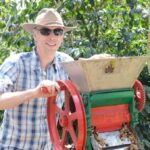We’re in Tarapoto now as Let’s Talk Coffee gets underway this morning. Well actually it began last night with a poolside welcome reception, but the program begins today.
But the fun really began for us lucky few who were able to attend the World Barista Forum in Lamas the night before last when the competitors from the Seed to Cup Challenge left their weeklong home on a Peruvian coffee farm.
Though obviously weary and bug-bitten, the baristas emerged from the darkness into the Oro Verde Co-op’s meeting house with a palpable sensation of enthusiasm and excitement from their experience. The challenge now, as discussed at the forum, is how to take that energy and translate it into action and communication for baristas and consumers who may never have the chance to visit origin let alone spend a week working side-by-side with a coffee farmer. Ideas included bringing baristas and farmers from origin to visit and work in cafes and roasters. Australian champion Scottie Callaghan said plans were already underway to do something similar between his company and one of their farmers in Sumatra. Additionally, baristas suggested spreading the Seed to Cup competition to other producing countries, where baristas, farmers and coffee organizations could put on their own events.
But concrete examples of benefits the baristas could bring to producing countries didn’t have to wait long. In the afternoon, we visited the co-op’s new cafe in Lamas. They recently opened the cafe, they said, in order to showcase their coffees to tourists, locals and the members. What they wanted to know from the baristas were some ways they might improve their cafe. The baristas broke into teams, put on their consulting hats, and developed 15-20 ideas the cafe could implement. Among the suggestions were things as simple as offering french press and aeropress (cheap, durable technologies that don’t require a lot of training), revamping the atmosphere of the cafe by highlighting the farmers and locations of where the coffee is grown and where it is sent. The meeting house boasts a number of beautiful murals, and the cafe could incorporate some of those to tell the story of its coffee. And doing something as simple as changing the layout moving the espresso machine, making the flow work a little better. The manager was enthusiastic about the numerous ideas and truly appreciated the input.
Today, too, plans are turning into action. As I type this the baristas are busy setting up stations to serve coffee via syphon, Chemex, pour-over, mypressi, and of course espresso. For many of the farmers who are here at LTC, it will be the first time they have ever tasted coffee prepared by any of these methods, and the baristas will be on hand to explain how the methods work, how they might best showcase their coffees and what methods of brewing are popular in consuming countries.
You can see a few pictures from yesterday on our flickr site: www.flickr.com/photos/baristamagazine
When I get back to the States I’ll post more photos, but the internet connection is a little slow here, so we’re limited in what we can post.
Copyright 2025 Barista Magazine



